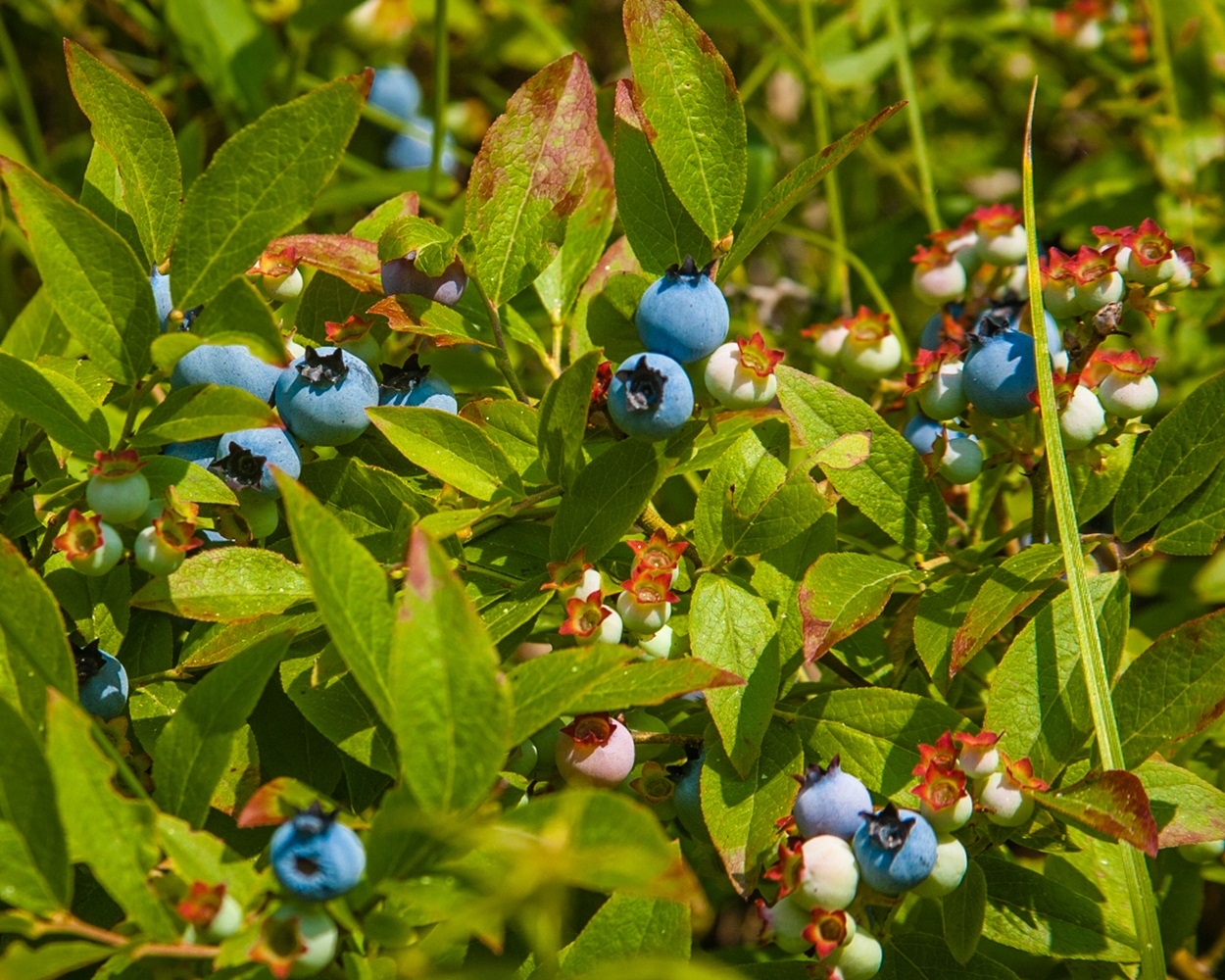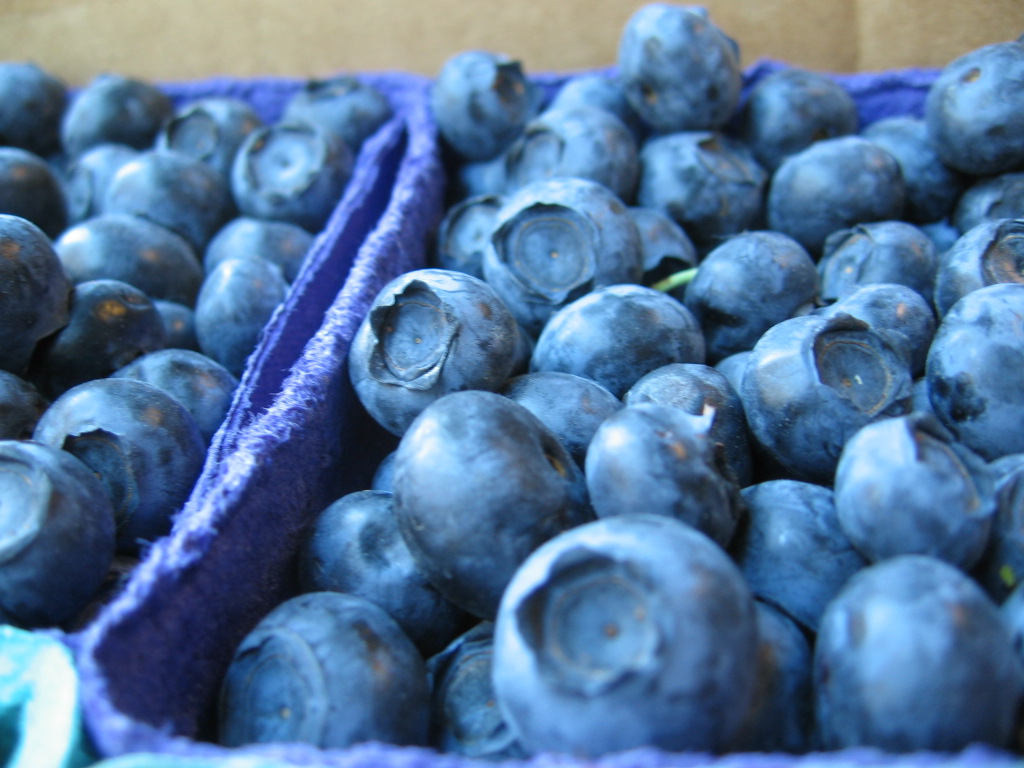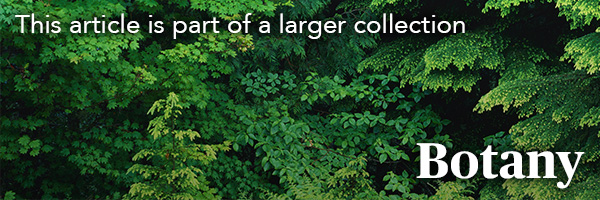Blueberries are a group of shrubs in the genus Vaccinium that bear edible blue, black or purple berries. The berries can be consumed fresh, frozen or dried. Their taste and health benefits contribute to their importance as an agricultural crop. Different blueberry species and cultivars are grown across Canada. Vaccinium is a cosmopolitan genus (i.e., with species found across the world) and is only absent from Australia and Antarctica. There are approximately 480 species, but only a limited number are thought of as blueberries. They are closely related to a few other edible Vaccinium species, including cranberries, lingonberries, huckleberries and grouseberries. Black- and blue-fruited huckleberries and bilberries are also often considered blueberries and are included here. Like other plants in the heath family (Ericaceae), blueberries naturally grow in acidic, often boggy soils, where other kinds of plants often struggle to extract sufficient nutrition. Across North America, Europe and Asia, there are at least 30 Vaccinium species that could be classified as blueberries. In Canada, that number is around a dozen. Most North American blueberries are deciduous shrubs, though there are a few evergreens. The deciduous leaves of blueberries are renowned for their brilliant orange to scarlet autumn colour.

Physical Description
The genus Vaccinium in North America is characterized by clusters of small, white, urn-shaped flowers and small, deciduous or, more rarely, evergreen leaves. These leaves are borne alternately along often ridged and angled stems. The berry forms from a single, multi-seeded ovary in the fertilized flower. Botanically, the blueberry fruit is a true berry. In most species, glaucous (bluish-white) waxes coat the fruit's skin, making it appear blue. The flowers can self-pollinate. However, insect pollination (especially by bumble bees) and the presence of multiple genetically different individuals tend to improve fruit size and increase fruit set. This is the case in natural colonies or where two or more highbush cultivars are grown in proximity.

Blueberry Species in Canada
Wild blueberry species (including blue- and black-fruited bilberries and huckleberries) native to Canada include:
|
Common Name |
Scientific Name |
Range |
|
Vaccinium angustifolium |
Eastern North America |
|
|
Northern blueberry |
Vaccinium boreale |
Northeastern United States, Quebec, Atlantic Provinces |
|
Dwarf blueberry |
Vaccinium caespitosum |
North America, Mexico, Guatemala |
|
Highbush blueberry |
Vaccinium corymbosum |
Eastern and Northwestern North America |
|
Blue-leaved huckleberry |
Vaccinium deliciosum |
Western North America |
|
Black huckleberry |
Vaccinium membranaceum |
Western North America, the Great Lakes |
|
Velvet-leaf blueberry, Canadian blueberry or sour-top |
Vaccinium myrtilloides |
Northeastern and Northern North America |
|
Low bilberry |
Vaccinium myrtillus |
Western North America, Europe, Japan, Northern Asia |
|
Oval-leaved blueberry |
Vaccinium ovalifolium (including Vaccinium alaskaense) |
Northeastern and Northwestern North America, Kamchatka Peninsula, Japan |
|
Evergreen huckleberry |
Vaccinium ovatum |
Coastal Western North America |
|
Hillside blueberry or dryland blueberry |
Vaccinium pallidum |
Eastern United States, Southern Ontario |
|
Bog blueberry |
Vaccinium uliginosum |
Northern North America, Greenland, Eurasia |
Genetic Diversity, Distribution and Habitat
All commercial blueberries are deciduous shrubs native to North America. Three of the most significant commercial species in Canada comprise two basic types: highbush and lowbush.
Commercial lowbush species, whose fruits are commonly referred to as wild blueberries, include Vaccinium angustifolium and, to a lesser extent, Vaccinium myrtilloides. Lowbush blueberries usually have smaller fruits compared to those of highbush blueberries. The berries are black or blue, and the flesh is sweet but acidic, resulting in tart, highly flavourful berries. These plants are mostly low-growing, sometimes forming extensive colonies from networks of shallow rhizomes (underground stems). Vaccinium angustifolium, which is native to eastern North America, seldom grows taller than 30 cm in height, while V. myrtilloides, which is native to northeastern and northern North America, can grow stems to 0.5 m or more.
The highbush blueberry, Vaccinium corymbosum, is a variable species native to much of Eastern North America. Plants normally grow taller than 1.5 m and do not form colonies. Like those of lowbush species, the leaves of highbush blueberries have dark blue-green foliage that turns variable shades of yellow, orange, red and purple in the autumn. Highbush blueberries have mostly larger, 6- to 12-mm-diameter, glaucous dark blue fruits that are tasty and sweet. The berries are less acidic, particularly with the cultivated selections, so they are blander than their wild counterparts. Upright shrubs, highbush blueberry plants have stems that frequently grow 2 to 3 m tall and can grow upwards of 5 m.
Pollinators and Wildlife
Blueberries are pollinated by flying insects, primarily bees. Honey bee hives are routinely set out in commercial blueberry fields in May and June to improve fruit sets and increase fruit size. In areas where local biodiversity is intact, native bees, especially buzz-pollinating bumble bees, are usually more effective for pollination services, since they are adapted to pollinating native species and are active during cooler temperatures. The stems of Vaccinium species, including all types of blueberries, are consumed by ungulates, such as deer, wapiti and moose, and the berries are an important food source for ruffed grouse, band-tailed pigeons and various songbirds. Black bears and grizzly bears also feed on the berries, leaves, stems and roots of blueberries.
Indigenous Peoples
Blueberries are widely used as food and medicine by Indigenous Peoples across Canada. However, the exclusion of Indigenous peoples from their lands and the banning of cultural practices have made it more difficult to access and consume berries. In Eastern Canada, this includes consumption by the Abenaki, Algonquin, Cree, Haudenosaunee, Anishinaabe and Mi'kmaq of various blueberry species, both fresh and dried. Mi’kmaq people also use the leaves and roots of lowbush blueberries to treat rheumatism. The Algonquin and Cree peoples use tea from the leaves to support women and infant health around pregnancy, and Algonquin people use a concentrated infusion from the roots. Blueberries are also an important traditional and cultural food of Inuit people, often picked together by an entire family. Berry picking has been linked to modern community well-being, and blueberries are among the most widely harvested plants by Inuit. In Western Canada, Indigenous communities cultivate several species of blueberries, and they are an important food source. Coast Salish peoples traded dried berries from the interior to the central coast, and within interior groups. Many Indigenous languages have a diversity of words used to describe to blueberries, signalling their traditional uses and cultural importance.
Indigenous berry-picking knowledge is important for determining harvest timing, locations and stewardship. Management practices include prescribed burning, pruning, fertilizing, mulching, berry transplanting and seed saving. These management practices promote habitat creation, increase food security and preserve species diversity.
Uses and Production
Lowbush blueberries are fire-adapted and naturally resprout after fire from the protected underground rhizomes. Taking advantage of this, management of lowbush patches typically consists of burning every other year to remove competing shrubs, trees, and any blueberry top growth. This practice helps fertilize the soil and invigorate the plants, resulting in vigorous growth in the spring after burning. Plants produce berries in the second year because only ripened, fully mature wood will bear flower buds. These buds open the following spring, and if fertilized, produce berries. Managed “wild” stands are common in Eastern Canada and the adjacent northeastern American states.
Like lowbush species (and most other Vaccinium species), highbush blueberry flowers and fruits are borne only on branches that have fully matured in the previous year. In contrast to lowbush blueberry management, pruning highbush blueberries consists of removing the oldest, non-productive stems annually or, more commonly, every few years from low on the main stem or near the ground.
There are over 78,000 hectares of blueberries in Canada, making it the largest fruit area in the country. Canada is the largest producer of lowbush blueberries in the world, which are predominantly harvested commercially in four provinces: Nova Scotia, New Brunswick, Prince Edward Island and Quebec. British Columbia produces nearly all of Canada’s highbush blueberries. Both lowbush and highbush blueberries are either handpicked or mechanically harvested. Once picked, blueberries are available for consumption in a variety of formats, including fresh, frozen IQF (Individual Quick Frozen), case frozen, dried/dehydrated, freeze-dried, powdered, as purée, juice, fruit filling or essence. Highbush and lowbush blueberries are harvested in approximately equal amounts, and much of the Canadian harvest of both types is exported internationally.
Health and Nutrition Benefits
Lowbush blueberries have been called a “superfruit” because of the variety of health benefits attributed to these small, blue fruits. Studies have shown that they are one of the richest sources of antioxidants of any fresh fruit or vegetable. Blueberries also contain anthocyanins (“antho” means flowering plant, and “cyanin” means blue), which are what give blueberries their blue colour. Blueberries are one of the richest sources of these pigments of any fruit, which have been shown to support heart health and blood sugar regulation. Blueberry consumption is also associated with a reduced risk of type 2 (late onset) diabetes and mitigating inflammation, and may improve memory and other aspects of cognition.

Threats and Challenges to Blueberry Conservation
Conserving the genetic variation within blueberries is critical. Conservation strategies include both in situ (species in their natural or semi-natural habitats) and ex situ (species found outside their natural habitats) approaches. One way to summarize the challenges and threats to blueberries is the acronym HIPPO, which stands for Habitat Loss, Invasive Species, Pollution, Human Population and Overharvesting (see Invasive Species in Canada: Animals and Invasive Species in Canada: Plants). These interacting factors are also compounded by the impacts of climate change, which is increasing unpredictable weather events such as heat domes, cold snaps and floods, significantly impacting the health of plants and their pollinators. It is important that the relatives of commercially grown blueberries (and their genetics), known as crop wild relatives (CWR), are also protected to ensure food security, especially in a changing climate.

 Share on Facebook
Share on Facebook Share on X
Share on X Share by Email
Share by Email Share on Google Classroom
Share on Google Classroom




